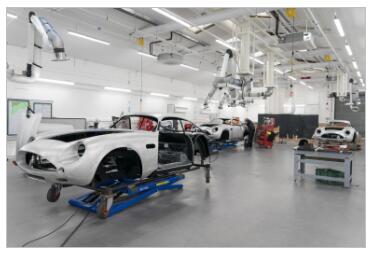Welcome to Sino Bearings web
24x7 HOTLINE:+86-28-81454188

 NEWS
NEWS
A never-to-be-repeated scene greets staff as they enter the new Continuation build facilities at the Aston Martin Works in Newport Pagnell, with no fewer than ten DB4 GT Zagato Continuation models currently going through a painstaking build process.
Production of the brand’s most valuable new car to date is now in full swing at the Heritage Division headquarters, and the combination of artisan handcraftsmanship and modern production facilities and logistics means multiple Continuation cars can be, for the first time, constructed alongside each other.
But this is no ordinary car production line. Indeed, the word ‘line’ implies a procession of cars; however, the process of hand-crafting the DB4 GT Zagato Continuation sports cars is much less clinical. Each individual Continuation car is the result of around 4,500 hours of detailed labour and meticulous handcrafting.
Paul Spires, President of Aston Martin Works, tells engineerlivemore.
Tell us about the original DB4 GT Zagatos
Each DB4GT rolling chassis – originally built at Aston Martin in Newport Pagnell, Buckinghamshire in the 1960s – was sent over to the Zagato factory in Milan for the fitment of the lightweight body designed by Ercole Spada.
Do any survive?
Of the 20 cars originally constructed, it is believed that 19 survive.
Are the new ones made from the same drawings?
The DB4 GT Zagato Continuation models are modern interpretations of the original cars. Digital scans of a number or original cars were taken, the data compared and a final design for the Continuation cars created by the Aston Martin Design team, led by Marek Reichman.
The car is designed and built to the highest standards, as with all modern Aston Martin sports cars.
How does the chassis differ? What’s it made of?
It’s made from mild-steel sections assembled in a very sophisticated chassis jig and is true to that of the original car. It is powder- and e-coated using the latest available technology.
The car features the original suspension geometry with the addition of spherical bearings to improve control on track. The shocks are unique to Aston Martin.
Steering is the original design, a rack and pinion system.
The gearbox is for the Zagato Continuation features a competition proven four-speed gearbox, plus reverse. It’s a straight cut dog engagement gearbox.
Wheels are original Borrani ones with Dunlop L section tyres.
How are new measuring techniques helping?
Digital scans of the cars, along with scans of major componentry such as engines, have allowed Aston Martin engineers to optimise the cars – thereby ensuring the highest possible levels of build quality, performance, and durability.
Aston Martin Works has always prided itself on delivering the highest quality of paint finishes to all our customers’ cars, including our Continuation models, and the business employs both artisan paint technicians and the highest quality materials to ensure this.
What’s in the Zagato Continuation cockpit?
The car features Smiths gauges, carried over from the DB4 GT.
Original materials are used wherever possible, while the race seats themselves are carbon FIA units for safety reasons,we have worked extremely hard to ensure all materials are as period as possible. However, we have of course employed modern materials in the safety systems such as the roll cage.
What new testing equipment is used along the assembly process?
Aston Martin Works uses the finest craftspeople and coachbuilders allied to the latest laser scanning and, of course, normal Aston Martin processes used in all sports car manufacturing sign-off to ensure the Zagato Continuation models meet the most stringent of applicable standards.
How will it be tested when completed?
The cars will undergo extensive track testing, as well as a suitable durability programme.
How much to buy a Zagato?
The DBZ Century Collection is priced at £6m plus taxes. First deliveries to customers will commence in QTR 4 2019 for the DB4 GT Zagato Continuation and in QTR 4 2020 for the DBS GT Zagato.